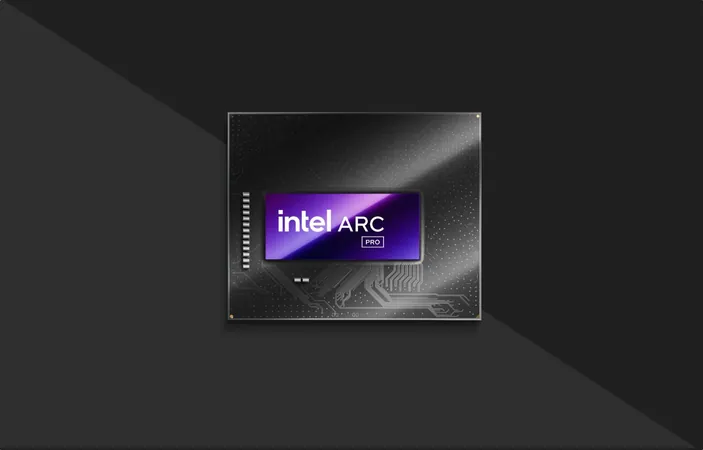
Intel's Bold Move in AI Workstations: Can They Undercut Nvidia?
2025-05-20
Author: Ken Lee
Intel's Game-Changer: The Battlemage Workstation Cards
At Computex, Intel is making waves with its newly launched Battlemage workstation cards. While the tech giant hasn't traditionally excelled in the AI accelerator arena, these affordable graphics cards could shift the landscape—especially for those on a budget!
An Affordable Alternative to High-End GPUs
For AI tasks, the spotlight isn't on the $299 Intel Arc B50, which is tailored more for traditional graphics workloads. Instead, it's all about the pricier B60 model, designed for intense graphics and AI inference applications. Although an official price hasn't been disclosed, Intel's Vivian Lien hints that the B60 could be around $500 per card—a fraction of the cost compared to Nvidia’s RTX 4000 series, which range from $1,250 to a staggering $2,400.
A Cost-Effective AI Solution
When it comes to AI inference, Nvidia’s RTX Pro 6000, released recently for about $8,565, boasts significantly higher performance metrics. Comparatively, the B60 represents an astonishingly lower price point—potentially just 1/17th the cost of Nvidia's offerings! While the B60 may lack in performance alone, Intel has a strategy to boost its capabilities through multi-GPU configurations.
Power in Numbers: Intel's Project Battlematrix
Intel envisions harnessing the power of multiple GPUs, suggesting configurations with up to eight B60 cards. This ‘Project Battlematrix’ strategy could yield impressive specs: around 1.5 petaOPS of performance, a whopping 192GB of vRAM, and 3.6TB/s memory bandwidth. If Lien's price estimation holds, you could assemble a powerful eight-GPU system for just $4,000—a steal compared to dual-GPU Nvidia systems!
Efficiency vs. Performance: What's the Trade-Off?
The B60’s lower power consumption (120W-200W) might seem appealing against the RTX Pro 6000’s hefty 300W-600W. However, it's essential to note that performance per watt leans heavily in Nvidia’s favor, particularly with their support for advanced data types. Even so, for many inference tasks, Intel's cards may perform adequately, especially in memory bandwidth-focused scenarios.
Harnessing User Flexibility in Multi-GPU Setups
In lab environments, Intel's strategy shines: imagine a setup where multiple researchers can concurrently run their workloads on dedicated GPUs. Intel plans to implement SR-IOV technology, allowing each of the eight GPUs to be partitioned for multiple users—an aspect that could revolutionize workloads in academic or R&D settings.
Make Way for Easier Software Deployment!
Software is the backbone of GPU performance, and Intel is keenly aware of this. The company has committed to enhancing its software tools, rolling out pre-baked container images for various AI frameworks. These containers aim to simplify the deployment process significantly, cutting through the hassle of dependency management. Initial offerings include support for frameworks such as vLLM, which will complement the B60’s launch.
Final Thoughts: A Competitive Landscape Ahead
With its Battlemage workstation cards, Intel is shaking up the AI hardware market. By prioritizing affordability and multi-GPU configurations, it aims to carve out a niche that could rival Nvidia’s high-priced dominance. If they can deliver on performance and software support, this could be a game-changer for a broad range of users looking for powerful AI solutions without breaking the bank!



 Brasil (PT)
Brasil (PT)
 Canada (EN)
Canada (EN)
 Chile (ES)
Chile (ES)
 Česko (CS)
Česko (CS)
 대한민국 (KO)
대한민국 (KO)
 España (ES)
España (ES)
 France (FR)
France (FR)
 Hong Kong (EN)
Hong Kong (EN)
 Italia (IT)
Italia (IT)
 日本 (JA)
日本 (JA)
 Magyarország (HU)
Magyarország (HU)
 Norge (NO)
Norge (NO)
 Polska (PL)
Polska (PL)
 Schweiz (DE)
Schweiz (DE)
 Singapore (EN)
Singapore (EN)
 Sverige (SV)
Sverige (SV)
 Suomi (FI)
Suomi (FI)
 Türkiye (TR)
Türkiye (TR)
 الإمارات العربية المتحدة (AR)
الإمارات العربية المتحدة (AR)